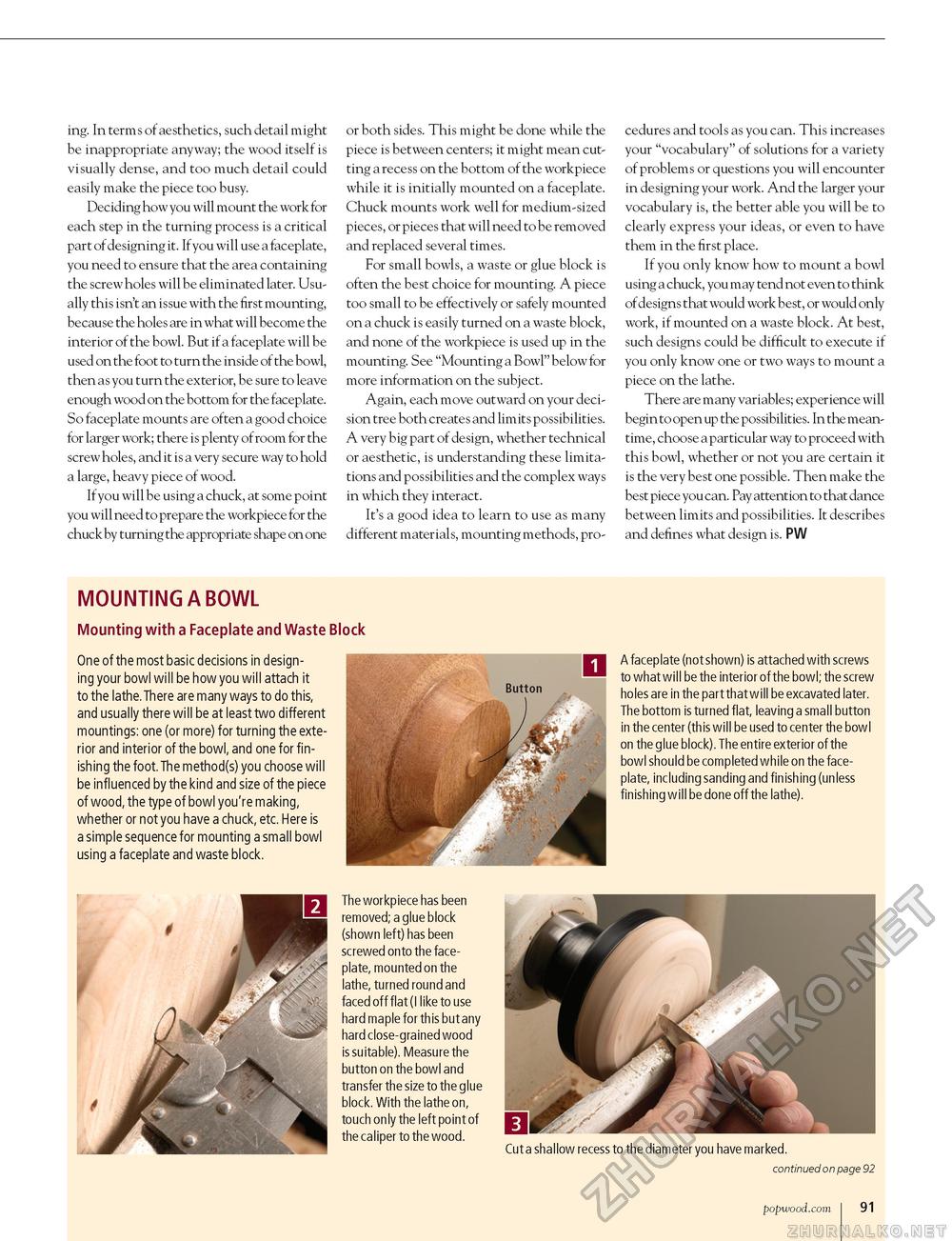Popular Woodworking 2005-08 № 149, страница 93
ing. In terms of aesthetics, such detail might be inappropriate anyway; the wood itself is visually dense, and too much detail could easily make the piece too busy. Deciding how you will mount the work for each step in the turning process is a critical part of designing it. If you will use a faceplate, you need to ensure that the area containing the screw holes will be eliminated later. Usually this isn't an issue with the first mounting, because the holes are in what will become the interior of the bowl. But if a faceplate will be used on the foot to turn the inside of the bowl, then as you turn the exterior, be sure to leave enough wood on the bottom for the faceplate. So faceplate mounts are often a good choice for larger work; there is plenty of room for the screw holes, and it is a very secure way to hold a large, heavy piece of wood. If you will be using a chuck, at some point you will need to prepare the workpiece for the chuck by turning the appropriate shape on one or both sides. This might be done while the piece is between centers; it might mean cutting a recess on the bottom of the workpiece while it is initially mounted on a faceplate. Chuck mounts work well for medium-sized pieces, or pieces that will need to be removed and replaced several times. For small bowls, a waste or glue block is often the best choice for mounting. A piece too small to be effectively or safely mounted on a chuck is easily turned on a waste block, and none of the workpiece is used up in the mounting. See "Mounting a Bowl" below for more information on the subject. Again, each move outward on your decision tree both creates and limits possibilities. A very big part of design, whether technical or aesthetic, is understanding these limitations and possibilities and the complex ways in which they interact. It's a good idea to learn to use as many different materials, mounting methods, pro cedures and tools as you can. This increases your "vocabulary" of solutions for a variety of problems or questions you will encounter in designing your work. And the larger your vocabulary is, the better able you will be to clearly express your ideas, or even to have them in the first place. If you only know how to mount a bowl using a chuck, you may tend not even to think of designs that would work best, or would only work, if mounted on a waste block. At best, such designs could be difficult to execute if you only know one or two ways to mount a piece on the lathe. There are many variables; experience will begin to open up the possibilities. In the meantime, choose a particular way to proceed with this bowl, whether or not you are certain it is the very best one possible. Then make the best piece you can. Pay attention to that dance between limits and possibilities. It describes and defines what design is. PW MOUNTING A BOWL Mounting with a Faceplate and Waste Block One of the most basic decisions in designing your bowl will be how you will attach it to the lathe. There are many ways to do this, and usually there will be at least two different mountings: one (or more) for turning the exterior and interior of the bowl, and one for finishing the foot. The method(s) you choose will be influenced by the kind and size of the piece of wood, the type of bowl you're making, whether or not you have a chuck, etc. Here is a simple sequence for mounting a small bowl using a faceplate and waste block. A faceplate (not shown) is attached with screws to what will be the interior of the bowl; the screw holes are in the part that will be excavated later. The bottom is turned flat, leaving a small button in the center (this will be used to center the bowl on the glue block). The entire exterior of the bowl should be completed while on the faceplate, including sanding and finishing (unless finishing will be done off the lathe). The workpiece has been removed; a glue block (shown left) has been screwed onto the faceplate, mounted on the lathe, turned round and faced off flat (I like to use hard maple for this but any hard close-grained wood is suitable). Measure the button on the bowl and transfer the size to the glue block. With the lathe on, touch only the left point of the caliper to the wood. Cut a shallow recess to the diameter you have marked. continued on page 92 popwood.com I 91 |








